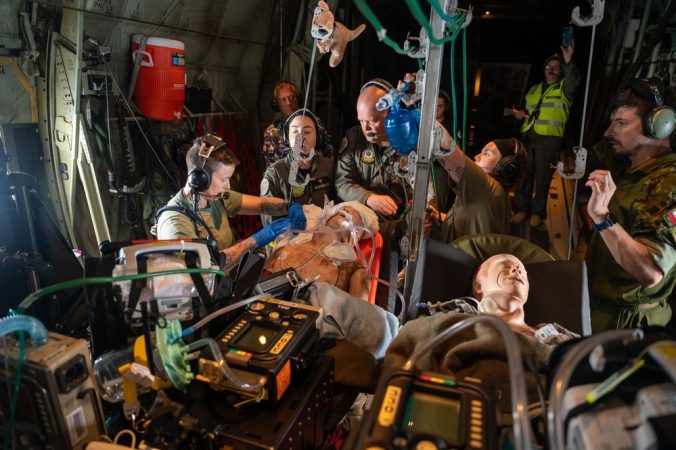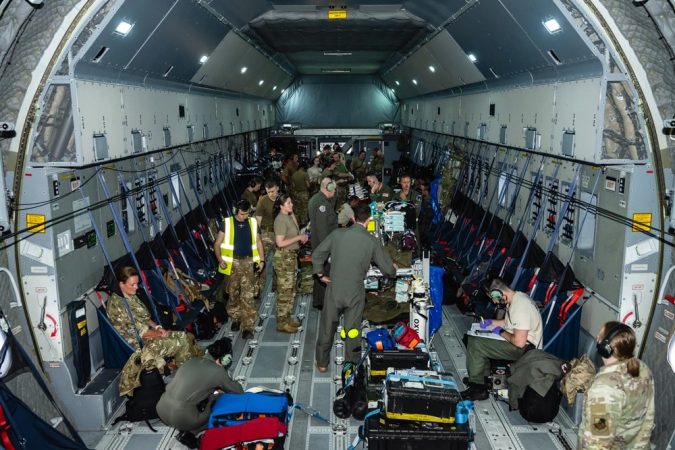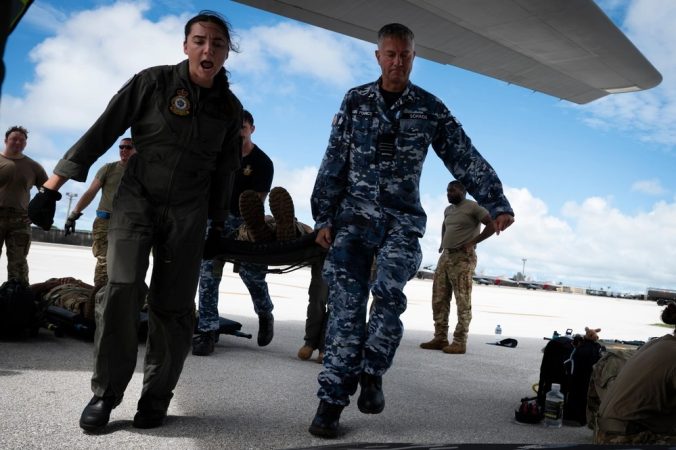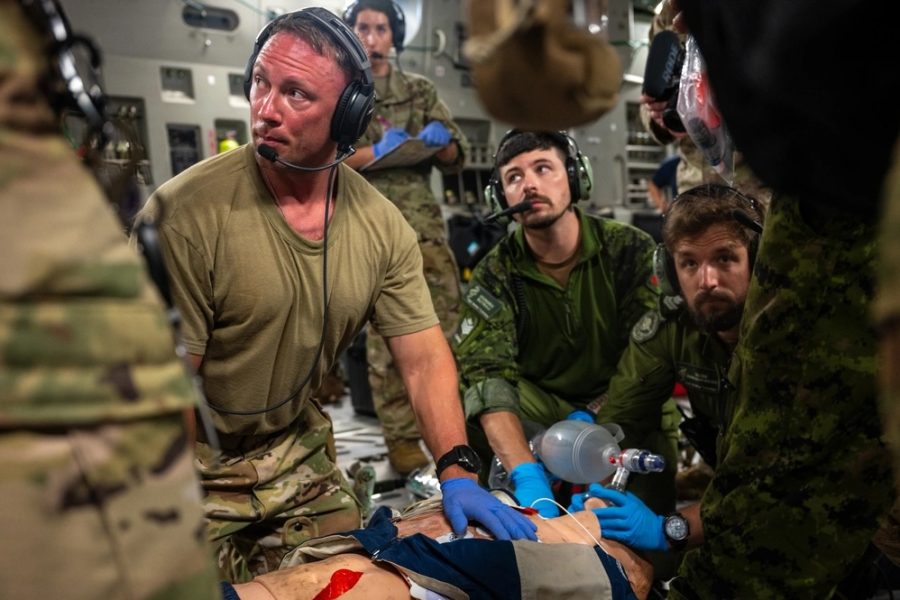ANDERSEN AIR FORCE BASE, Guam—The Irish playwright George Bernard Shaw is often credited for the saying “England and America are two countries separated by the same language,” and few places is that saying more true than the world of aeromedical evacuation, where differences in terminology, technology, training, and authority make integrating medics from two countries a challenge even when they speak the same language.
This summer, U.S. AE crews practiced mass-casualty response and in-flight patient care with medics from Australia, Canada, New Zealand, the U.K., and Japan to get used to working together in high-stress and tight quarters.
“Opportunities like this, where we get to train with different forces, expose our Airmen to what other countries use, will make it a lot easier in a high-pressure scenario,” said Col. Jennifer Cowie, deputy for aeromedical evacuation in the Air Force’s training and readiness directorate.
The training took place during the Department-Level Exercise, a new wargame where about 12,000 Airmen and Guardians practiced air combat, airlift, aerial refueling, aeromedical evacuation, and other missions across the Pacific.
The Pacific Ocean is too big for the U.S. Air Force to be everywhere at once. So if the U.S. or allied militaries take casualties in a conflict with China, the aeromedical evacuation Airmen charged with caring for injured troops on their way to higher levels of treatment may need to work with allies and partners to get the job done.
During the wars in Iraq and Afghanistan “we could dedicate an entire plane and several crews to move one person all the way back to stateside,” Cowie said. “Over here, you probably are not going to have the resources to dedicate to something like that. That’s where relying on our partners for shorter flights to a country nearby would be helpful.”

Easier said than done, and the differences start with language. For example, U.S. medics use the brand name Tylenol, but much of the rest of the world refers to the same drug by its active ingredient, paracetamol. Medics from different countries may use the terms Bactrim, Septra, or Cotrim to refer to the same antibiotic.
Beyond different words, medics from different countries may also have different strength and dosage standards.
“The drugs might be slightly different, the concentration of drawing those drugs up are also different,” said Royal Australian Air Force Squadron Leader Sharon Johnson. “So if we use double-strength or quad-strength, they’ll use single-strength.”
That could have serious implications when, for example, an AE crew runs out of a medication to keep a ventilated patient sedated over a long Pacific flight and needs to use a partner nation’s medication, said Maj. Will Colas, a critical care aeromedical evacuation specialist with the Royal Canadian Air Force.
“We’re used to preparing medication the Canadian way, the U.K. way, or the American way,” he said. “So even if the molecule may be the same, the packaging [and] the way that it’s labeled is not the same. We need to get used to that so we don’t make mistakes when we prepare the medication.”
Ironing out those details requires communication, but that can also be a challenge when AE crews from different countries use different messaging apps and intercom headsets. Johnson said some crews use the app Signal to chat, while others use WhatsApp and still others use Mattermost, where U.S. Airmen have higher security access than foreign partners.
“What we recognized is that there are little pockets of how folks are communicating,” Cowie said. “How are we going to effectively get the message to our partners?”

The same struggle applies to patient tracking: the U.S. system requires an American service member’s Common Access Card, which makes it inaccessible to most foreign troops. Sometimes crews from different countries literally can’t talk to each other on the same aircraft when their wireless intercom headphones don’t mesh (military aircraft are usually too loud to have a normal conversation without headsets), so they use a runner to ferry messages between the two crews or ask one crew to bring extra headsets, Johnson said.
AE crews from different countries often bring different sets of tools to the job. U.S. crews use liquid oxygen, while Australian crews sometimes use gas oxygen, which means they have to bring different cables to be interoperable. U.S. crews plug their medical devices into a C-17 to use the aircraft’s electricity, but other countries prefer to stay on battery power.
Each country has its own network of safety testing, regulations, and policies that result in the different sets of equipment, explained Lt. Col. Darrell Lee, AE branch chief at the training and readiness directorate at Air Force headquarters.
“We spend so much money making sure this thing plugs in and doesn’t blow up the plane,” he said. “But I think other countries should trust also that that will work on another C-17 or C-130 that their country flies as well.”
Then there are different rules about who can do what: for example, American med techs and flight nurses have a fairly wide scope of practice, but others may be more limited, Lee said.
“If you’re flying with a tech from New Zealand, for example, and they can’t do X, Y, and Z, but they’re the only tech on there, then you have a gap,” he said.

And finally there are process differences: how crews load and unload a plane with patients, or how they do a hand-over between aircraft.
“There’s a way to prepare to make sure that when we are in the middle of the flight line, under the rain, the patients still receive the best care,” said Colas. “Inside the aircraft, it’s okay. Inside the hospital, it’s okay. But in between, those patients are highly injured, highly in pain, so we need to make sure that there is no gap between them.”
The AE crews had several opportunities to work through those differences at the DLE, starting with a show-and-tell where the different nationalities took turns setting up a C-130 with their standard AE layout and then walking visitors through it. A group of U.S. med techs were wowed by an Australian’s idea to hang racks of medical supplies on the sides of the cabin rather than stuff the gear into crates, and that discovery grew into a conversation about the different ways each group does business.
Later on in the DLE, a British team led a combined crew of American, British, Australian, and New Zealander medics aboard a British A400 transport plane. Similar groups worked together aboard a C-17 and a C-5 carrying five patients to Hawaii, which let the crews “experience long-range mission planning as well as the use of a new aircraft,” Lee and Cowie said in written responses shared after the exercise.
“We shared new pharmacology, equipment and aircraft configurations which improves our overall capacity to work together,” they said. “Ideally, the more we can expose our crews to working with other countries and nations, the sooner we can develop comfort and reliance on each other’s capabilities.”


